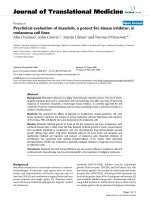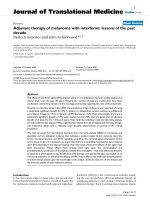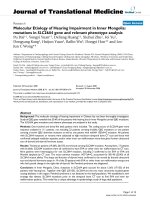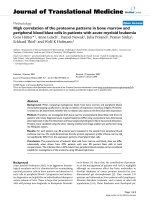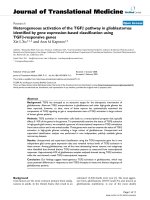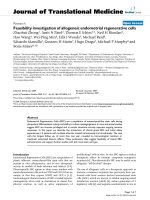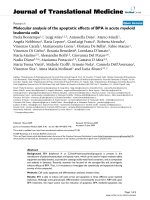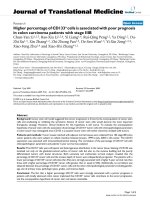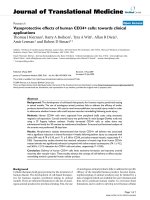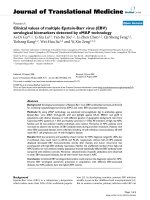báo cáo hóa học: " Pictorial Representation of Illness and Self Measure Revised II (PRISM-RII) – a novel method to assess perceived burden of illness in diabetes patients" pptx
Bạn đang xem bản rút gọn của tài liệu. Xem và tải ngay bản đầy đủ của tài liệu tại đây (392.68 KB, 7 trang )
BioMed Central
Page 1 of 7
(page number not for citation purposes)
Health and Quality of Life Outcomes
Open Access
Research
Pictorial Representation of Illness and Self Measure Revised II
(PRISM-RII) – a novel method to assess perceived burden of illness
in diabetes patients
Sandor Klis
1
, Ad JJM Vingerhoets
1
, Maartje de Wit
2
, Noortje Zandbelt
2
and
Frank J Snoek*
2
Address:
1
Clinical Psychology Section, Tilburg University, Warandelaan 2, Tilburg, The Netherlands and
2
Department of Medical Psychology, VU
University Medical Center, Van der Boechorststraat 7, Amsterdam, The Netherlands
Email: Sandor Klis - ; Ad JJM Vingerhoets - ; Maartje de Wit - ;
Noortje Zandbelt - ; Frank J Snoek* -
* Corresponding author
Abstract
Background: The Pictorial Representation of Illness and Self Measure (PRISM) has been
introduced as a visual measure of suffering. We explored the validity of a revised version, the
PRISM-RII, in diabetes patients as part of the annual review.
Methods: Participants were 308 adult outpatients with either type 1 or type 2 diabetes. Measures:
(1) the PRISM-RII, yielding Self-Illness Separation (SIS) and Illness Perception Measure (IPM); (2) the
Problem Areas in Diabetes (PAID) scale, a measure of diabetes-related distress; (3) the WHO-5
Well-Being Index; (4) and a validation question on suffering (SQ). In addition, patients' complication
status, comorbidity and glycemic control values(HbA1c) were recorded.
Results: Patients with complications did have marginally significant higher scores on IPM,
compared to patients without complications. Type 2 patients had higher IPM scores than Type 1
patients. SIS and IPM showed low intercorrelation (r = 25; p < .01). Convergent validity of PRISM-
RII was demonstrated by significant correlations between IPM and PAID (r = 0.50; p < 0.01), WHO-
5 (r = 26; p < 0.01) and SQ (r = 0.36; p < 0.01). SIS showed only significant correlations with PAID
(r = -0.28; p < 0.01) and SQ (r = -0.22; p < 0.01). Neither IPM nor SIS was significantly associated
with HbA1c. The PRISM-RII appeared easy to use and facilitated discussion with care providers on
coping with the burden of diabetes.
Conclusion: PRISM-RII appears a promising additional tool to assess the psychological burden of
diabetes.
Background
Living with a chronic disease like diabetes requires consid-
erable psychological adjustment. Failure to adjust ade-
quately to the disease may have negative consequences for
the patient's quality of life, possibly resulting in suffering.
An important outcome of this adjustment is the amount
of suffering that a disease potentially causes. Although
suffering is frequently mentioned in the medical litera-
Published: 27 November 2008
Health and Quality of Life Outcomes 2008, 6:104 doi:10.1186/1477-7525-6-104
Received: 23 May 2008
Accepted: 27 November 2008
This article is available from: />© 2008 Klis et al; licensee BioMed Central Ltd.
This is an Open Access article distributed under the terms of the Creative Commons Attribution License ( />),
which permits unrestricted use, distribution, and reproduction in any medium, provided the original work is properly cited.
Health and Quality of Life Outcomes 2008, 6:104 />Page 2 of 7
(page number not for citation purposes)
ture, its definition and characteristics are often implied
rather than defined. One definition that has been fre-
quently cited is that of Cassell [1]: 'a state of severe distress
associated with events that threaten the intactness of the
person'. From this definition, it follows that the extent of
suffering is not merely determined by the severity of the
illness itself, but rather by the perceived threat it poses to
the intactness of the self, i.e. the impact and meaning a
disease has for a patient. In addition, personality factors
are assumed to play an important role in coping with the
illness [2].
The Pictorial Representation of Illness and Self Measure
(PRISM), has recently been introduced as a generic meas-
ure of suffering [3]. This 'circle test' consists of a rectangu-
lar sheet of paper, with a yellow disk in the bottom right
corner. Patients are instructed to imagine that the sheet
represents their life, and the yellow disk their self, and to
place a red disk which represents their illness, somewhere
on the sheet, to reflect the position of the illness in their
life. The distance between the centers of the two disks is
labelled the Self-Illness Separation (SIS). Following Pin-
cus and Morley [4], a separation between illness and self
schema is assumed to signify a healthy adjustment to the
illness.
The PRISM, assessing the subjective position of one's ill-
ness in relation to the self, seems to match this definition
rather well. Indeed, a study among lupus patients found
support for this 'enmeshment hypothesis' [5]. However,
as the PRISM is a rather abstract instrument, and no
golden standard measure of suffering exists, its validation
yields serious problems. Nevertheless, studies in patients
with rheumatoid arthritis [6], chronic obstructive pulmo-
nary disease [7], systemic lupus erythematosus [8], psoria-
sis [9], vitiligo [10], and chronic pain [11] have provided
evidence suggesting that PRISM measures aspects of suf-
fering, and a validation study with over 700 patients from
different disease groups showed PRISM to have good test-
retest reliability, and to be sensitive to therapeutic change
[12]. In addition, the PRISM has been found useful in dif-
ferentiating alcohol-related disorders [13], and in assess-
ing post-traumatic growth in bereaved parents [14].
Because the measure is generic, it allows for comparison
of suffering not only across different diseases, but even
including problems of a different nature. In a recent pilot
study, using a modified version of the PRISM, substantial
differences in SIS were found between different diseases,
with breast cancer and lung disease patients reporting
higher SIS than whiplash and infertility patients [15].
In the current study we aimed to assess whether a modifi-
cation of the original PRISM task, the PRISM-RII [15] is a
feasible and valid instrument for measuring suffering in
people with diabetes. Diabetes was chosen, since this con-
dition is a highly prevalent chronic disease that is known
to cause considerable distress, related both to the symp-
toms and complications of the disease as well as the daily
demands of self-management [16-18].
Much similar as in the Wouters et al. study [15], in the
present study the original PRISM was also modified in
three ways, without changing the conceptualisation of the
measure. First, the single red illness-disk was replaced by
three different sized illness disks (respectively smaller
than, equal to and larger than the self disk), from which
respondents were asked to choose one. This yielded an
additional variable, the Illness Perception Measure (IPM),
operationalized as the size of the chosen disk. IPM is
hypothesized to measure the perceived severity of the ill-
ness. In addition, as a second variable SIS was computed
measuring the perceived position of the illness in the
patient's life. A second revision implied that the yellow
self-disk was moved to the middle of the sheet, in the
center of a large printed circle. This was done to make the
visual analogy of the relative positions of illness and self
more intuitive; it is easier to envisage that the self is
located in the centre of one's life than in the bottom right
corner. In addition, in our experience with the original
PRISM, several patients put the illness disk in the center of
the sheet, commenting that their disease took a central
position in their lives. Finally, the PRISM-RII was admin-
istered computer-based.
If the PRISM-RII is a measure of diabetes-related suffering,
the following predictions should be confirmed. First, as
the amount of suffering is likely to be moderated by dis-
ease status, patients with diabetes related complications
or comorbid disorders might be hypothesized to report
more intrusiveness compared to those without complica-
tions or comorbid disorders, which might be reflected in
a smaller IPM and higher SIS values. Second, SIS and IPM
should be moderately intercorrelated, without suggesting
redundancy. Finally, IPM and SIS are expected to be mod-
erately related with measures of well-being and diabetes
related distress, confirming convergent validity.
Methods
Patient sample
Three-hundred and eight diabetes patients participated in
this study. The whole sample had a mean age of 50.7 years
(SD = 16.9, range 19–89). Both sexes were equally repre-
sented. One-hundred and nineteen patients were diag-
nosed with type 1 diabetes. These patients had a mean age
of 43.6 years (SD = 14.4, range 19–82). One-hundred
eighty-nine patients were diagnosed with type 2 diabetes.
These patients had a mean age of 59.8 years (SD = 13.1,
range 28–89). Of the whole sample, 46% had at least one
diabetes-related complication. Patients completed the
questionnaires as part of the annual review at the Diabetes
Health and Quality of Life Outcomes 2008, 6:104 />Page 3 of 7
(page number not for citation purposes)
Outpatient Clinic of the VU University Medical Centre
(VUMC) in Amsterdam, the Netherlands [19]. The study
was approved by the Medical Ethical committee of the
VUMC, and all participants gave written permission to use
their (anonymous) data for scientific purposes.
Measures
The Pictorial Representation of Illness and Self Measure Revised II
(PRISM-RII)
The PRISM-RII [15], consists of a large white circle (186
mm in diameter), representing the respondents' life, with
a yellow disk (52 mm in diameter) placed in the middle
and in front of the white disk, representing the respond-
ents' self (Figure 1). Three differently sized red disks were
shown on the left side of the circle, representing the
respondents' illness. The illness disks were respectively
smaller than, equal to, and larger than the self disk (35
mm, 52 mm, and 65 mm in diameter). Patients were
given the following written instruction: 'The white circle
represents your current life and the yellow disk represents
you. The three red disks represent your diabetes. Select
from the three red disks the one which, in your view, rep-
resents your diabetes most accurately. Using the mouse,
drag this disk into your life. Locate the disk at the place
that the diabetes occupies in your life. You can place the
disk anywhere in your life, also entirely or partially on top
of your self.' Two measures were extracted from the
PRISM-RII: Self Illness separation (SIS) in pixels, ranging
from 0 to 300, and the Illness Perception Measure, rang-
ing from 1 to 3, with 1 representing the smallest disk.
Problem Areas in Diabetes (PAID)
The Dutch version of the PAID [20] was used to asses dia-
betes related distress. For each of its 20 items, patients are
requested to indicate how problematic these aspects of
diabetes are for them, ranging from 0 (no problem) to 4
(a big problem). The Dutch version of the PAID has been
shown to be reliable (Cronbach's alpha.95). Total score is
calculated by summation of scores, standardized to a 0–
100 range.
World Health Organization 5 Well-being Index (WHO-5)
The WHO-5 is a brief measure of well-being that consists
of five positively worded items rated on a 6-point scale
ranging from 0 (not present) to 5 (constantly present).
Total score is calculated by summation of scores, stand-
ardized to a 0–100 range. The WHO-5 covers positive
mood, vitality, and general interests. The measure has
been derived from the WHO-10 and has good psychomet-
ric properties [21-24]. Also, both the WHO-10 and WHO-
5 have been validated in diabetic patients [25,26].
Suffering Question (SQ)
The participants additionally were requested to answer
the question 'How much do you suffer from your diabe-
tes?' on a 5-point scale, anchored by not at all (0), and
very much (4). This question served to evaluate content
validity of the PRISM-RII.
Biomedical parameters
Medical data were retrieved from the patient charts.
Patients' most recent HbA1c values were documented as
an index of glucose control (reflecting the past 6–8
weeks). Values below 7.0% are considered satisfactory. In
Addition, the presence of diabetes-related complications
(nephropathy, neuropathy, retinopathy, and ulceritis),
and comorbidity (e.g. hypertension, rheumatoid arthritis)
were documented. For statistical purposes, both variables
were scored as 0 (no complications or comorbidity), or 1
(one or more complications or comorbid diseases).
Statistical analysis
Means and standard deviation of the various self-report
measures were calculated. Differences between male and
female participants and between type 1 and type 2 diabe-
tes were examined for all measures using Student's t-tests.
Mean differences in scores on the PRISM-RII, WHO-5, and
PAID between patients with and without complications
and/or comorbidity were tested using Students t-tests, as
an indication of discriminant validity.
Convergent validity of the PRISM-RII was assessed by cal-
culating mutual Pearson's correlation coefficients
between SIS, IPM, PAID and WHO-5. The validity of
PRISM-RII for both type 1 and type 2 diabetes was evalu-
ated by computing these correlations for each subtype.
Fisher-z transformations of these correlations were used
to examine whether these correlations differed signifi-
cantly from one another.
Results
Means and standard deviations for all variables are dis-
played in Table 1.
Type of diabetes
Compared to people with type 1 diabetes, people with
type 2 diabetes had a significantly higher IPM score (t = -
2.34, p < .05), and scored significantly higher on the
PAID. There were no significant type of diabetes differ-
ences for SIS.
Complications and comorbidity
Patients with complications had a marginally significant
higher score on IPM (t = -1.76, .05 <p < .10), than patients
without complications, but SIS did not differ significantly
(t = 045, n.s.). Patients with complications had signifi-
cantly higher scores on the PAID (t = -1.97, p < .05), and
SQ (t = -2.96, p < .01), and significantly lower scores on
the WHO-5 (t = 2.01, p < .05). Patients with comorbid dis-
orders scored significantly higher on the PAID (t = -2.31,
Health and Quality of Life Outcomes 2008, 6:104 />Page 4 of 7
(page number not for citation purposes)
The PRISM (top) and the PRISM-RII (bottom)Figure 1
The PRISM (top) and the PRISM-RII (bottom).
Health and Quality of Life Outcomes 2008, 6:104 />Page 5 of 7
(page number not for citation purposes)
p < .05), but did not differ significantly on any of the other
measures.
Convergent validity
Correlations between PRISM-RII (IPM and SIS) and other
variables are presented in Table 2. The correlation
between SIS and IPM was low but significant (r = 23; p <
.01). As expected, IPM correlated significantly positively
with PAID (r = .50, p < .01) and negatively with WHO-5 (r
= 26, p < .01). SIS correlated significantly negatively with
the PAID (r = 28, p < .01), but showed no significant
association with WHO-5 (r = .08, p > .10). Neither IPM
nor SIS correlated significantly with HbA1c (r = .06, p >
.10; r = .05, p > .10, respectively). SIS and IPM both
showed, opposite, significant associations with SQ (SIS: r
= .22, p < .01; IPM: r = 36, p < .01). Compared to men,
women scored significantly higher on the PAID (t = -2.00,
p < .05), and significantly lower on the WHO-5 (t = 2.98,
p < .01). Women also scored higher on the IPM, and this
difference approached statistical significance (t = -1.85, p
< .10). There were no significant gender differences for
SIS. Comparisons of Fisher-z transformations of type-spe-
cific correlations between SIS, IPM, WHO-5, and PAID
yielded no significant differences between patient groups.
Discussion
The aim of the present study was to evaluate the validity
of the PRIMS-RII as a measure of suffering in people with
diabetes.
Although the concept of suffering is abstract, the vast
majority of patients was able to complete the PRISM-RII
without any difficulty. As for validity, although the
PRISM-RII variables did not differentiate between patients
with and without complications and comorbidity, both
measures were moderately related to diabetes-related dis-
tress, as assessed by PAID, while IPM was additionally
associated negatively with well-being. In contrast, no
association was found between well-being and SIS. This
may be related to the more general nature of the well-
being construct as measured with the WHO-5, covering
issues such as vitality and interest in daily activities.
Indeed, there is currently discussion whether generic well-
being questionnaires are suitable for use in specific illness
populations [27,28]. Another possibility is that the rela-
tionship between quality of life and suffering is more
complex than assumed. Well-being is a construct empha-
sizing, in particular, positive emotions, whereas suffering
is a construct focussing mainly on negative mood states.
This difference might be important, since it has been well
established that the presence of negative affect does not
necessarily imply the absence of positive affect and vice
versa [29]. In that sense, it could be that the positive con-
struct of well-being and the negative construct of suffering
might be relatively independent of each other. Alterna-
tively, it has been suggested by Cassell [2] that the ability
to give meaning might be a key factor in suffering. More
precisely, according to this view a low quality of life is
only experienced as suffering if the patient experiences a
low quality of life and lacks the capacity to give meaning.
Future studies should be specifically designed to test this
intriguing hypothesis.
We failed to find an association between the PRISM vari-
ables and HbA1c as a measure of glycaemic control. This
Table 1: Means and standard deviations of SIS, IPM, SQ, WHO-5, PAID, and HbA1c.
Whole sample
N = 308
Type I
N = 119
Type II
N = 189
t-test for differences
Mean (SD) Mean (SD) Mean (SD)
SIS 129.6 (99.2) 118.7 (89.2) 136.5 (104.6) n.s.
IPM 1.8 (0.7) 1.7 (0.7) 1.9 (0.7) *
SQ 1.7 (1.2) 1.6 (1.1) 1.8 (1.2) *
WHO-5 64.0 (21.8) 66.6 (16.7) 62.5 (24.4) (*)
PAID 23.2 (19.5) 19.9 (16.3) 25.2 (21.1) *
HBA1C 7.9 (1.1) 7.9 (1.1) 7.9 (1.1) n.s.
SIS = Self-Illness Separation; IPM = Illness Perception Measure; SQ = Suffering Question; WHO-5 = World Health Organisation 5 Well Being Index;
PAID = Problem Areas in Diabetes.
n.s. = p > 0.10; (*) 0.05 ≤ p ≤ 0.1, * p ≤ 0.05,
Table 2: Correlations between PRISM-RII measures and SQ,
WHO-5, PAID, HbA1c and age.
IPM SIS
IPM -0.25**
SIS -0.25**
SQ 0.36** -0.22**
WHO-5 -0.26** 0.08
PAID 0.50** -0.28**
HBA1C 0.06 0.05
Age 0.03 0.21**
SIS = Self-Illness Separation; IPM = Illness Perception Measure; SQ =
Suffering Question; WHO-5 = World Health Organisation 5 Well
Being Index; PAID = Problem Areas in Diabetes.
** p ≤ 0.01
Health and Quality of Life Outcomes 2008, 6:104 />Page 6 of 7
(page number not for citation purposes)
is not unexpected, as HbA1c values do not translate into
tangible symptoms, particularly not in patients with rea-
sonably well-controlled diabetes. The fact that the pres-
ence of diabetes-related complications and comorbidity
was associated with elevated levels of emotional distress
but only marginally or not at all with PRISM-variables is
counterintuitive. It would suggest that PRISM is less sensi-
tive to diabetes-specific burden than for example the
PAID. Moreover, SQ also differed significantly between
patients with and without complications, while it was sig-
nificantly associated with IPM or SIS. More precisely, and
as might be expected, a high score on SQ (indicative of
more suffering) was related to a lower SIS and a higher
IPM. This might be considered as supporting the content
validity, i.e. whether PISMR-II is a 'pure' measure of suffer-
ing or perhaps also reflects adaptation or coping. Support
for this hypothesis further comes from the comments of
the patients, who frequently referred to (the success of)
their own coping efforts (e.g., "I make sure my diabetes
does not become too big an issue in my life"). In a previ-
ous study among individuals with problematic alcohol
use, Reinhardt et al. [13] also found SIS to discriminate
between different levels of readiness to change, which also
reflects coping efforts. SIS was partly predicted by age,
indicating older people on average having higher SIS
scores. This finding suggests more successful adaptation to
the disease with increasing age. In additional analysis we
controlled for disease duration, showing that this factor
per se did not predict SIS, nor did it attenuate the signifi-
cance of age as a predictor of SIS.
Further research into the content validity of PRISM-RII is
warranted, including cognitive debriefing sessions. It is
not clear if using a single question on degree of suffering
in this context is indeed helpful. First, it should be obvi-
ous that the concept of suffering is not easily measured
with only one (direct) question. The response to this ques-
tion hinges entirely on the respondents implicit conceptu-
alisation of suffering, which may differ considerably
among patients. Also, suffering may have a strong nega-
tive connotation. Perhaps when asked bluntly, suffering is
a 'hit or miss' construct, meaning that it is hardly possible
to suffer a little bit, as suffering is always associated with
serious discomfort. Although responses on the SQ did not
approach a binomial distribution, 26% of subjects
reported a large amount of suffering, whereas for SIS, 38%
of subjects responded in the lowest quarter of possible
responses (from 0 to 80), indicative of a large amount of
suffering. These differences in distribution also argue in
favour of measuring suffering with a visual and indirect
method such as the PRISM-RII.
The PRISM has been proven useful in measuring aspects
of suffering in several groups of patients, and can be used
to compare data across different diseases. However, less is
known about how to interpret the relationship between
SIS and IPM, which intercorrelate only moderately. SIS is
intended to measure the perceived relationship between
the patient's self and the illness, which serves as an indica-
tor of suffering. For SIS, a whole or partial overlap of the
illness disk with the self may be indicative of a high level
of suffering, or, more precisely, strong efforts to cope with
living with diabetes. Patients report a variety of explana-
tions in cases of overlap, including "diabetes is a part of
me and my life, that is why it overlaps". IPM is intended
to measure the patients' perception of the magnitude or
severity of the illness. It is tempting to speculate about the
correspondence of IPM and SIS with, respectively, prob-
lem focused coping (coping efforts to reduce or neutralize
the impact of a stressor, in this case the disease) and emo-
tion focused coping (leaving the stressor as it is, but try to
better deal with the stressor and its consequences). On the
other hand, it could be argued that IPM is more strongly
related to PAID and WHO-5, because these latter meas-
ures assess the negative impact of diabetes on well-being.
Indeed, IPM correlated more strongly with these measures
than SIS. Future studies specifically designed to address
this issue will yield additional valuable information about
the PRISM-RII.
Conclusion
The PRISM-RII might be a feasible and valid instrument to
capture aspects of diabetes-related suffering, unrelated to
objective illness characteristics. The PRISM-RII is easily
administered, and offers a good starting point for clinical
conversations. Future studies should confirm whether
PRISM yields additional relevant information to existing
measures of psychological well-being and insight into the
patients' illness perceptions. The non-verbal PRISM-RII is
a promising tool that can be used both in research and
clinical settings, in particular also patients with language
problems and, maybe, children.
Competing interests
The authors declare that they have no competing interests.
Authors' contributions
SK contributed to data collection, performed the statistical
analysis and drafted the manuscript. AV designed the
computerized PRISM-R measure and contributed to the
manuscript.
MdeW contributed to the quality of data management
and the manuscript. NZ coordinated the assessments in
the diabetes outpatient clinic and data management. FJS
conceived of the study, participated in its design and con-
tributed to the manuscript. All authors read and approved
the final manuscript.
Publish with BioMed Central and every
scientist can read your work free of charge
"BioMed Central will be the most significant development for
disseminating the results of biomedical research in our lifetime."
Sir Paul Nurse, Cancer Research UK
Your research papers will be:
available free of charge to the entire biomedical community
peer reviewed and published immediately upon acceptance
cited in PubMed and archived on PubMed Central
yours — you keep the copyright
Submit your manuscript here:
/>BioMedcentral
Health and Quality of Life Outcomes 2008, 6:104 />Page 7 of 7
(page number not for citation purposes)
References
1. Cassell EJ: The nature of suffering. In The nature of suffering and
the goals in Medicine Edited by: Cassell EJ. New York: Oxford Univer-
sity Press; 1991:31-47.
2. Cassell EJ: Diagnosing suffering: A perspective. Ann Intern Med
1999, 131:531-4.
3. Büchi S, Sensky T, Sharpe L, Timberlake N: Graphic representa-
tion of illness: A novel method of measuring patients' per-
ception of the impact of illness. Psychother Psychosom 1998,
67:222-5.
4. Pincus T, Morley S: Cognitive-processing bias in chronic pain: a
review and integration. Psychol Bull 2001, 127:599-617.
5. Denton F, Sharpe L, Schrieber L: PRISM: Enmeshment of illness
and self-schema. Psychother Psychosom 2004, 73:57-63.
6. Büchi S, Sensky T, Sharpe L, Timberlake N: Graphic representa-
tion of illness: A novel method of measuring patients' per-
ception of the impact of illness. Psychother Psychosom 1998,
67:222-225.
7. Büchi S, Brändli O, Klinger K, Klaghofer R, Buddeberg C: Stationäre
Rehibilitation bei Patienten mit Chronisch Obstruktiver
Lungen-Krankheit (COLK) – Effekte auf körperliche Leis-
tungsfähigkeit, psychisches Wohlbefinden und Lebensqual-
ität. Schweiz Med Wochenschr 2000, 130:135-142.
8. Büchi S, Villiger P, Kauer Y, Klaghofer R, Sensky T, Stoll T: PRISM
(Pictorial Representation of Illness and Self Measure) – a
novel visual method to assess the global burden of illness in
patients with systemic lupus erythematosus. Lupus 2000,
9:368-373.
9. Reimus JL, Vingerhoets AJ, Soons PH, Korstanje MJ: Suffering in
psoriasis patients: its relation with illness severity and sub-
jective well-being. Int J Dermatol 2007, 46:1042-5.
10. Rumpf HJ, Löntz W, Uesseler S: A self-administered version of a
brief measure of suffering: first aspects of validity. Psychother
Psychosom 2004, 73:53-6.
11. Kassardjian CD, Gardner-Nix J, Dupak K, Barbati J, Lam-McCullock J:
Validating PRISM (Pictorial Representation of Illness and
Self Measure) as a Measure of Suffering in Chronic Non-Can-
cer Pain Patients. J Pain 2008 in press.
12. Büchi S, Buddeberg C, Klaghofer R, Russi EW, Brändli O, Schlösser C,
Stoll T, Villiger PM, Senski T: Preliminary validation of PRISM
(Pictorial Representation of Illness and Self Measure) – A
brief method to assess suffering. Psychother Psychosom 2002,
71:333-41.
13. Reinhardt S, Bischof G, Grothues J, John U, Rumpf HJ: Performance
of the pictorial representation of illness and self measure in
individuals with alcohol dependence, alcohol abuse or at-risk
drinking. Psychother Psychosom 2006, 75:249-56.
14. Büchi S, Mörgeli H, Schnyder U, Jenewein J, Hepp U, Jina E, Neuhaus
R, Fauchère JC, Bucher HU, Sensky T: Grief and post-traumatic
growth in parents 2–6 years after the death of their
extremely premature baby. Psychother Psychosom 2007,
76:106-14.
15. Wouters EJM, Reimus JLM, van Nunen AMA, Blokhorst MGBG,
Vingerhoets AJJM: Suffering quantified? Feasibility and psycho-
metric characteristics of two revised versions of the Pictorial
Representation of Illness and Self Measure (PRISM). J Behav
Med 2008, 34:65-78.
16. Rubin RR, Peyrot M: Psychological issues and treatments for
people with diabetes. J Clin Psychol 2001, 57:457-78.
17. West C, McDowell J: The distress experienced by people with
type 2 diabetes. Br J Community Nurs 2002, 7:606-13.
18. McVeigh KH, Mostashari F, Thorpe LE: Serious psychological dis-
tress among persons with diabetes. Morb Mortal Wkly Rep 2004,
53:1089-1092.
19. Zandbelt N, de Wit M, Lubach CHC, Breas N, Snoek FJ: Monitoring
individual needs in persons with diabetes: results of an ongo-
ing, nurse-led well-being assessment as part of the annual
review [abstract]. Diabetologia 2007, 50:s440.
20. Snoek F, Pouwer F, Welch G, Polonsky W: Diabetes-Related
Emotional Distress in Dutch and U.S. Diabetic Patients. Dia-
betes Care 2000, 23:1305-1309.
21. Bech P, Olsen LR, Kjoller M, Rasmussen NK:
Measuring well-being
rather than the absence of distress symptoms: a comparison
of the SF-36 Mental Health subscale and the WHO-Five
Well-Being Scale. Int J Methods Psychiatr Res 2003, 12:85-91.
22. Lowe B, Spitzer RL, Grafe K: Comparative validity of three
screening questionnaires for DSM-IV depressive disorders
and physicians' diagnoses. J Affect Disorders 2004, 78:131-140.
23. Henkel V, Mergl R, Kohnen R, Allgaier AK, Moller HJ, Hegerl U: Use
of brief depression screening tools in primary care: consider-
ation of heterogeneity in performance in different patient
groups. Gen Hosp Psychiat 2004, 26:190-198.
24. Moller Leimkuhler AM, Heller J, Paulus NC: Subjective well-being
and 'male depression' in male adolescents. J Affect Disord 2007,
98:65-72.
25. Bech P, Gudex C, Johansen KS: The WHO (Ten) Well-Being
Index: validation in diabetes. Psychother Psychosom 1996,
65:183-190.
26. Shea SSS, Bech P, Kalo I, Home P: Routine assessment of psycho-
logical well-being in people with diabetes – validation of the
WHO-5 Well-being Index in six countries. Diabetologia 2003,
46(2 Suppl):A88.
27. Wiebe S, Guyatt G, Weaver B, Matijevic S, Sidwell C: Comparative
responsiveness of generic and specific quality-of-life instru-
ments. J Clin Epidemiol 2003, 56:52-60.
28. Murawski MM, Miederhoff PA: On the generalizability of statisti-
cal expressions of health related quality of life instrument
responsiveness: a data synthesis. Qual Life Res 1998, 7:11-22.
29. Watson D, Clark L, Tellegen A: Development and validation of
brief measures of positive and negative affect: the PANAS
scales. J Pers Soc Psychol 1988, 54:1063-1070.
